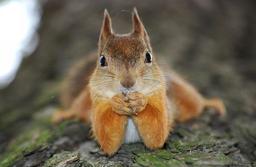
Adaptations
Quiz by Stephen Joseph DCruz
Feel free to use or edit a copy
includes Teacher and Student dashboards
Measure skillsfrom any curriculum
Measure skills
from any curriculum
Tag the questions with any skills you have. Your dashboard will track each student's mastery of each skill.
With a free account, teachers can
- edit the questions
- save a copy for later
- start a class game
- automatically assign follow-up activities based on students’ scores
- assign as homework
- share a link with colleagues
- print as a bubble sheet
52 questions
Show answers
- Q1Male humpback whales sing and make beautiful sounds to attract ____________female30s
- Q2________________ are usually strong and muscular.predators30s
- Q3________________ has long tail to help it maintain balance during a high-speed chase.cheetah30s
- Q4Some mammals such as seals and dugongs have nostrils at the top of their snouts. They push their nostrils above the water surface to breathe, or close them to keep water out when they are underwater. This is an example of ___________________ [(structural adaptation (their body is different) or behavioural adaptation (they behave differently)]behavioural adaptationstructural adaptation45s
- Q5Woodpeckers have a strong sturdy beak with a chisel-like tip to peck holes in the tree trucks to look for insects and worms. This is an example of ___________________ [(structural adaptation (their body is different) or behavioural adaptation (they behave differently)]structural adaptationbehavioural adaptation30s
- Q6Eagles are known for their sharp vision that helps them to spot prey on the ground even when they are in the air. This is an example of ___________________ [(structural adaptation (their body is different) or behavioural adaptation (they behave differently)]structural adaptationbehavioural adaptation30s
- Q7Snakes use venom to stun, kill or paralyse their prey. This is an example of ___________________ [(structural adaptation (their body is different) or behavioural adaptation (they behave differently)]structural adaptationbehavioural adaptation30s
- Q8Wolves hunt in packs (groups) so that they can take down larger and stronger animals. This is an example of ___________________ [(structural adaptation (their body is different) or behavioural adaptation (they behave differently)]behavioural adaptationstructural adaptation30s
- Q9Venus flytrap has lobes that work like a trap. When something alive come sin contact with the tiny hairs on the trap, the lobes trap shut rapidly. This is an example of ___________________ [(structural adaptation (their body is different) or behavioural adaptation (they behave differently)]behavioural adaptationstructural adaptation30s
- Q10Chameleon changes colour to blend in with the environment to escape from _____________predators30s
- Q11Some fish move around in large groups so they can take turns to feed and keep a look out for _____________predators30s
- Q12Coconuts are adapted to be dispersed by water. They have a thick shell to prevent seawater from damaging the seeds and they have a buoyant hull to keep it floating. This is an example of ___________________ [(structural adaptation (their body is different) or behavioural adaptation (they behave differently)]behavioural adaptationstructural adaptation30s
- Q13Dandelions have light and fluffy seeds that can be carried away easily by wind. This is an example of ___________________ [(structural adaptation (their body is different) or behavioural adaptation (they behave differently)]behavioural adaptationstructural adaptation30s
- Q14Camels store water in their humps.FalseTrue30s
- Q15Adaptations allow the _________________ to reproduce.Users re-arrange answers into correct orderJumble45s